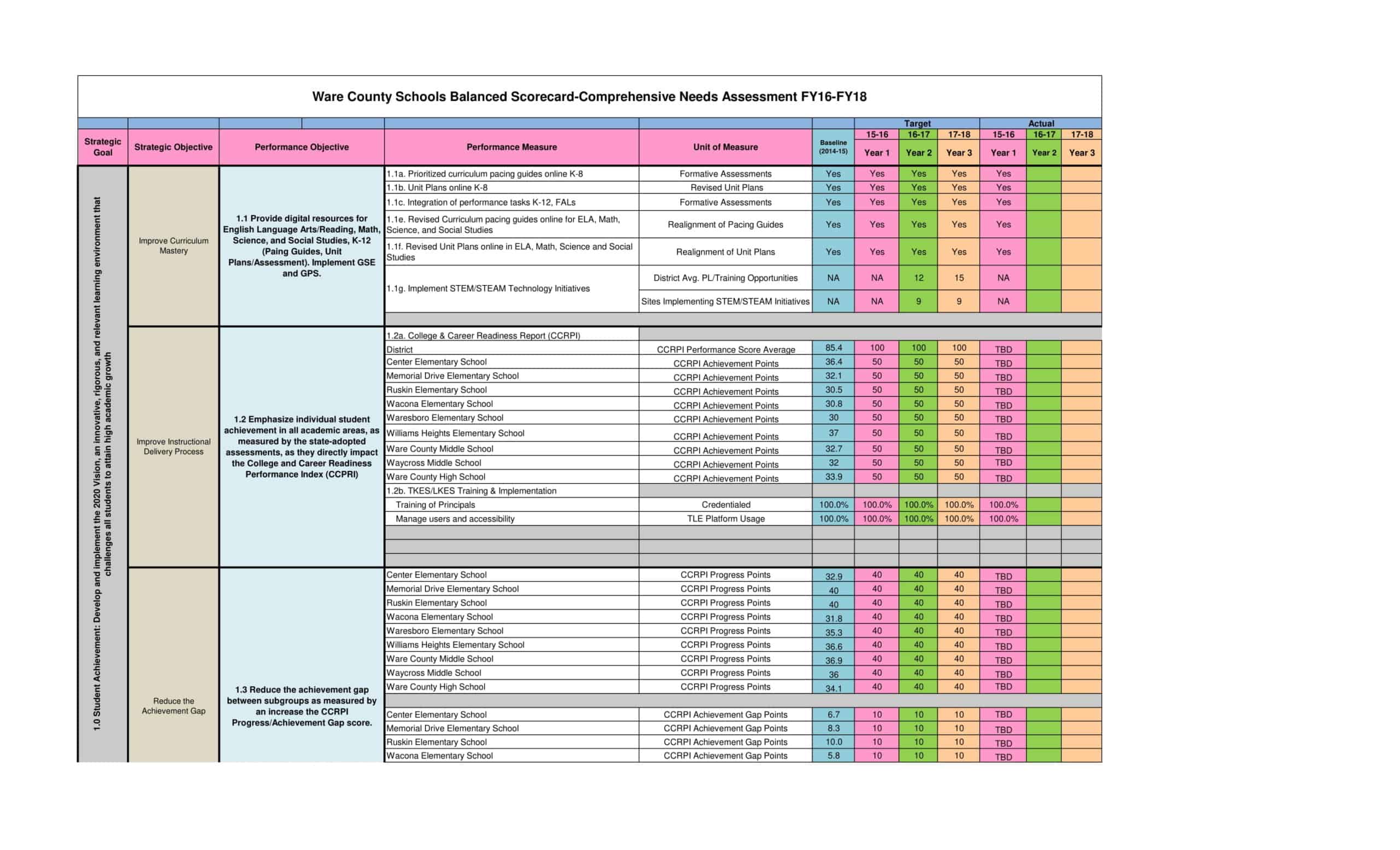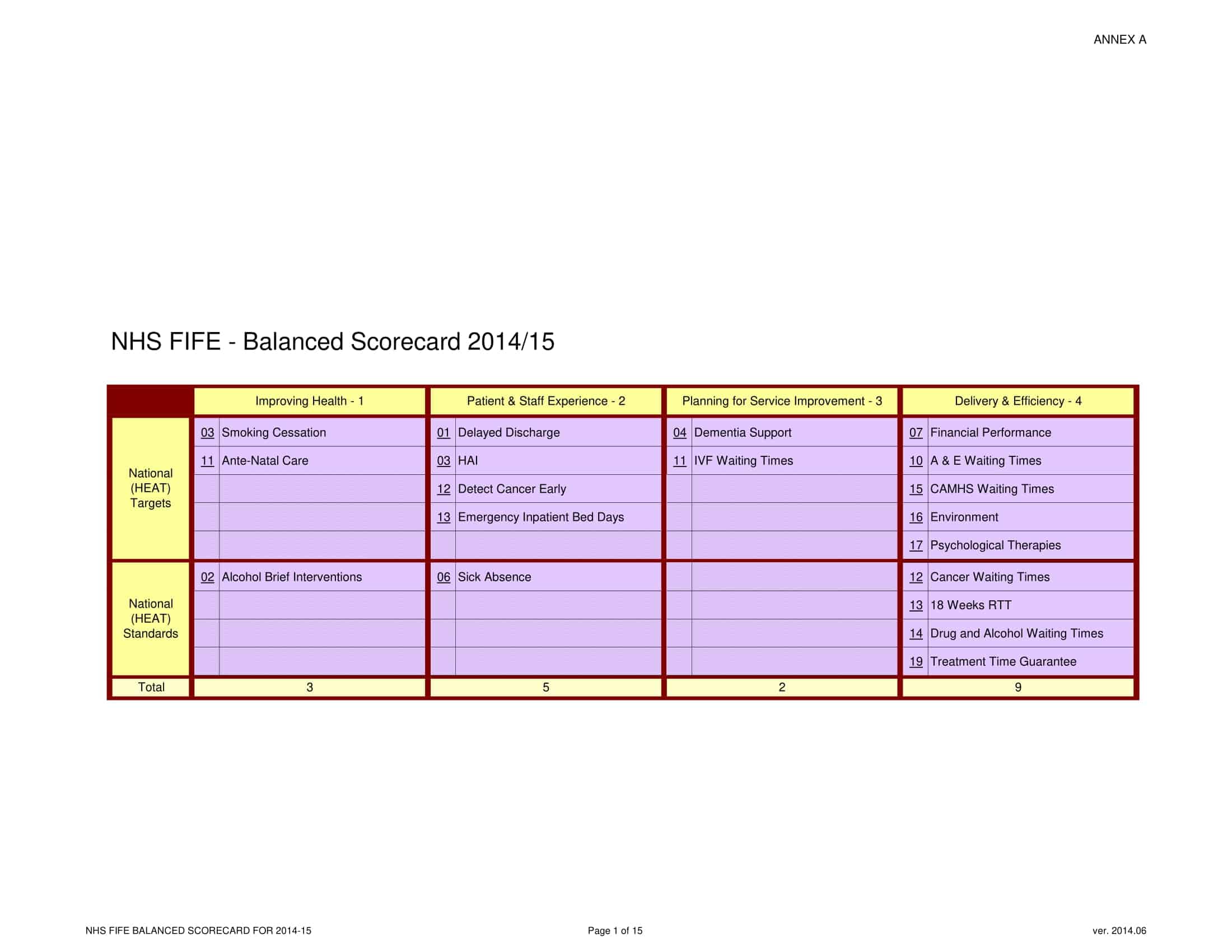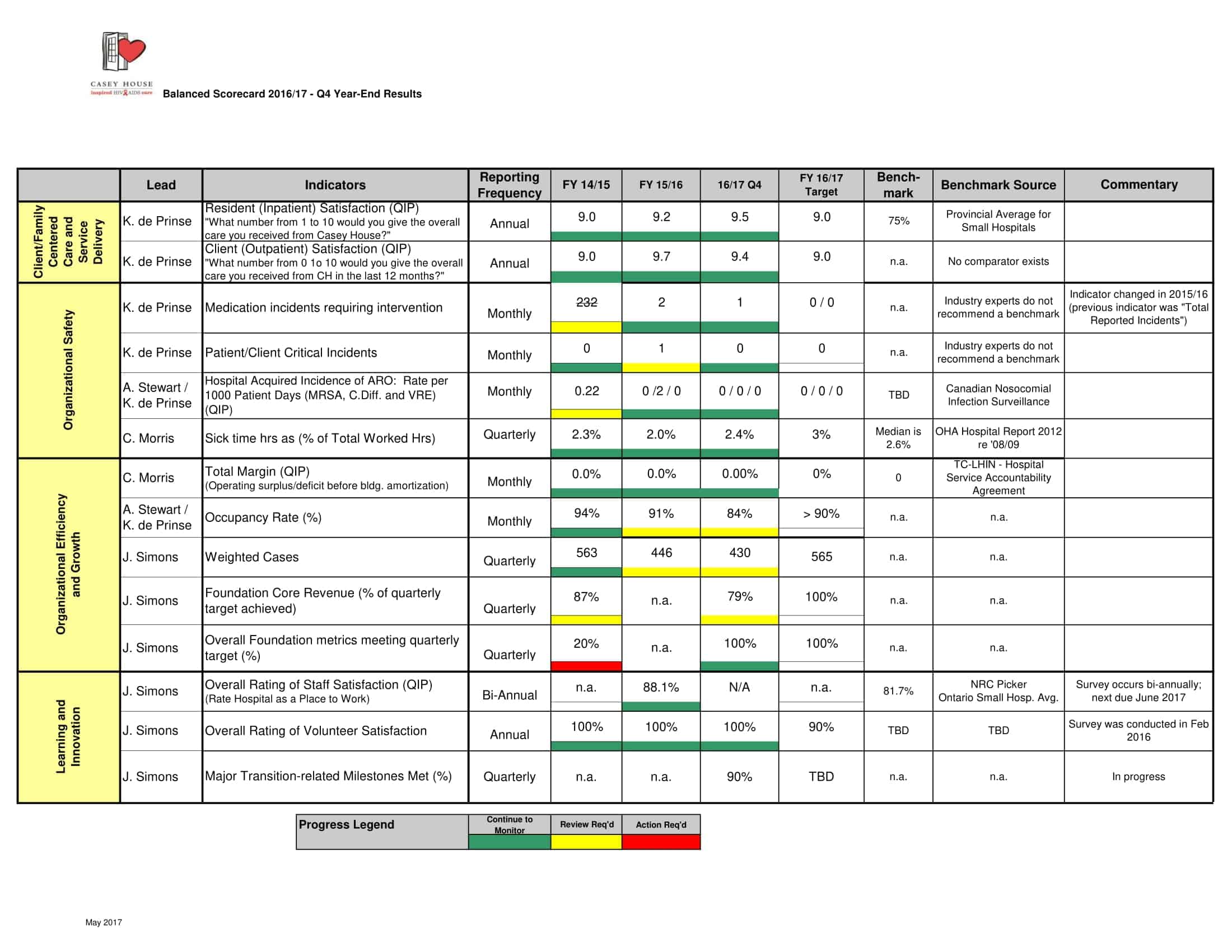Performance measurement is crucial for businesses to adapt to changing market needs, but traditional financial accounting methods often fail to accurately reflect a company’s true performance. That’s where the balanced scorecard comes in.
The balanced scorecard is a performance management tool that combines financial and non-financial measures to give a more comprehensive view of a company’s performance. In this article, we will explain how the balanced scorecard can help your company thrive in today’s competitive business environment.
Table of Contents
Balanced Scorecard Templates
Balanced scorecard templates are pre-designed tools that assist organizations in measuring and managing their performance across multiple key areas. These templates provide a framework for evaluating and monitoring various aspects of an organization’s operations, such as financial performance, customer satisfaction, internal processes, and employee development.
Balanced scorecard templates typically include sections or categories for each of the key areas that are important to the organization’s success. These areas are often represented by key performance indicators (KPIs) that are carefully selected to reflect the organization’s strategic objectives and goals. The template also allows for the tracking and visualization of data over time to identify trends and measure progress.
Using a balanced scorecard template enables organizations to have a holistic view of their performance, moving beyond financial indicators to include other critical factors that contribute to their overall success. It helps align the organization’s activities with its strategic objectives and facilitates communication and collaboration among different departments or teams.
What Is a Balanced Scorecard Template?

A balanced scorecard template is a tool used to track and evaluate the performance of a business or organization. It typically includes a set of metrics or measures that are categorized into four perspective: financial, customer, internal process, and learning and growth.
The purpose of the balanced scorecard template is to provide a holistic view of the organization’s performance by considering a range of factors, rather than just financial outcomes. The balanced scorecard template can be used to track progress towards specific goals, identify areas of strength and weakness, and make informed decisions about how to improve performance. It is often presented in the form of a visual dashboard or report, with each perspective represented by a set of key performance indicators (KPIs) or metrics. The template can be customized to fit the needs and goals of the specific business or organization using it.
Why Use a Balanced Scorecard Template?
There are several reasons why a business or organization might choose to use a balanced scorecard template:
Comprehensive performance evaluation: The balanced scorecard template allows businesses to evaluate their performance using a range of metrics that go beyond just financial measures. This gives a more complete view of the organization’s overall performance.
Goal alignment: The balanced scorecard template can help businesses align their performance with their goals and objectives by tracking progress towards specific targets in each of the four perspectives.
Identify strengths and weaknesses: The balanced scorecard template can help businesses identify areas of strength and weakness by comparing performance across different metrics and perspectives.
Continuous improvement: By tracking performance over time and identifying areas for improvement, the balanced scorecard template can help businesses continuously improve their performance.
Decision making: The balanced scorecard template can provide the information needed to make informed decisions about how to allocate resources and improve performance.
The Four Perspectives of the Balanced Scorecard
The balanced scorecard is a performance management tool that evaluates a business or organization using four perspectives: financial, customer, internal process, and learning and growth. These four perspectives are designed to provide a comprehensive view of the organization’s performance, rather than just relying on financial measures. Here is a brief overview of each of the four perspectives:
Financial perspective: The financial perspective measures the organization’s financial performance, such as profitability, return on investment, and cash flow.
Customer perspective: The customer perspective measures how well the organization is meeting the needs and expectations of its customers, such as customer satisfaction, loyalty, and retention.
Internal process perspective: The internal process perspective measures how efficiently and effectively the organization’s processes are being carried out, such as quality, efficiency, and innovation.
Learning and growth perspective: The learning and growth perspective measures the organization’s ability to continuously improve and adapt, such as employee development, knowledge management, and organizational culture.
How to Create a Balanced Scorecard
Here is a detailed guide on how to draw a balanced scorecard:
Step 1: Define your strategy and goals
The first step in creating a balanced scorecard is to define your organization’s strategy and goals. This will help you determine which metrics and measures are most important to track. Consider your organization’s mission and vision, as well as any long-term goals or objectives that have been set.
Step 2: Identify key performance indicators (KPIs)
Once you have defined your strategy and goals, the next step is to identify the key performance indicators (KPIs) that will be used to measure your organization’s performance. These should be specific, measurable, achievable, relevant, and time-bound (SMART). It’s important to choose KPIs that are aligned with your strategy and goals, and that will help you track progress towards those objectives.
Step 3: Choose a visualization tool
There are many different tools and software options available for creating a balanced scorecard. Some common options include spreadsheet software like Excel, specialized balanced scorecard software, or presentation software like PowerPoint. Choose a tool that is easy for you and your team to use, and that allows you to customize and update your balanced scorecard as needed.
Step 4: Create the balanced scorecard template
Once you have chosen a visualization tool, it’s time to create the actual balanced scorecard template. Start by dividing the template into four sections, one for each of the four perspectives: financial, customer, internal process, and learning and growth. Within each section, list the KPIs that will be used to measure performance in that perspective. It’s a good idea to include both leading and lagging indicators, as well as both quantitative and qualitative measures.
Step 5: Populate the template with data
Once you have created the balanced scorecard template, the next step is to populate it with data. This will typically involve collecting data from various sources, such as financial reports, customer surveys, internal process metrics, and employee development records. It’s important to ensure that the data is accurate, up-to-date, and relevant to the KPIs being tracked.
Step 6: Analyze the data
Once you have collected and populated the balanced scorecard with data, the next step is to analyze it. This will typically involve comparing performance against target values or benchmarks, and identifying any areas of strength or weakness. It may also involve identifying trends or patterns over time, or comparing performance across different departments or business units.
Step 7: Use the results to inform decision making
The final step in the process is to use the results of the balanced scorecard analysis to inform decision making. This may involve identifying areas for improvement, allocating resources, or making changes to business processes or strategies. It’s important to use the results of the balanced scorecard to drive continuous improvement and support the overall mission and vision of the organization.
Things to Avoid When Creating Your Balanced Scorecard
Here are a few things to avoid when creating your balanced scorecard template:
Choosing the wrong metrics: It’s important to choose metrics that are aligned with your organization’s strategy and goals, and that accurately reflect your performance. Avoid choosing metrics that are not relevant or meaningful, or that do not provide useful information.
Focusing too much on lagging indicators: While lagging indicators are important for tracking overall performance, it’s also important to track leading indicators that can help you identify potential problems or opportunities before they occur.
Ignoring qualitative measures: While quantitative measures are important for tracking performance, it’s also important to consider qualitative measures such as customer satisfaction, employee engagement, and organizational culture. These can provide valuable insights into your organization’s performance.
Not collecting data regularly: To get the most value out of your balanced scorecard, it’s important to collect data regularly and update your template on a regular basis. This will allow you to track progress and identify trends over time.
Not involving the right people: To be effective, the balanced scorecard should be a collaborative effort that involves input and buy-in from all levels of the organization. Make sure to involve key stakeholders in the process of creating and using the balanced scorecard.
Not using the results to drive continuous improvement: The balanced scorecard should not be a one-time exercise, but rather a continuous process of performance measurement and improvement. Make sure to use the results of the balanced scorecard to inform decision making and drive continuous improvement.
FAQs
How is the balanced scorecard used?
The balanced scorecard is typically used to track progress towards specific goals, identify areas of strength and weakness, and make informed decisions about how to improve performance. It is often presented in the form of a visual dashboard or report, with each perspective represented by a set of key performance indicators (KPIs) or metrics. The balanced scorecard can be customized to fit the needs and goals of the specific business or organization using it.
What are the four perspectives of the balanced scorecard?
The four perspectives of the balanced scorecard are financial, customer, internal process, and learning and growth. The financial perspective measures the organization’s financial performance, such as profitability and cash flow. The customer perspective measures how well the organization is meeting the needs and expectations of its customers. The internal process perspective measures how efficiently and effectively the organization’s processes are being carried out. The learning and growth perspective measures the organization’s ability to continuously improve and adapt.
What are key performance indicators (KPIs)?
Key performance indicators (KPIs) are specific, measurable, achievable, relevant, and time-bound (SMART) metrics used to track the performance of a business or organization. They are used to measure progress towards specific goals and objectives, and to identify areas of strength and weakness. KPIs can be quantitative, such as financial measures, or qualitative, such as customer satisfaction scores.
What are leading and lagging indicators?
Leading indicators are metrics that can help predict future performance, while lagging indicators reflect past performance. Leading indicators are typically more forward-looking and can help identify potential problems or opportunities before they occur. Lagging indicators, on the other hand, are typically used to track overall performance and to measure the success of past actions. It’s important to include both leading and lagging indicators in a balanced scorecard to get a complete view of performance.
How often should a balanced scorecard be updated?
The frequency of updating a balanced scorecard will depend on the specific needs and goals of the business or organization using it. Some organizations may choose to update their balanced scorecard monthly or quarterly, while others may update it on a more frequent basis, such as weekly or daily. It’s important to update the balanced scorecard regularly to ensure that the data is accurate and up-to-date, and to track progress towards goals and objectives.
How do you choose the right metrics for a balanced scorecard?
When choosing metrics for a balanced scorecard, it’s important to consider your organization’s strategy and goals, as well as the specific needs and objectives of the business or organization. Metrics should be specific, measurable, achievable, relevant, and time-bound (SMART), and should align with your overall strategy and goals. It’s also important to choose a mix of leading and lagging indicators, as well as both quantitative and qualitative measures.
How do you use the results of a balanced scorecard?
The results of a balanced scorecard should be used to inform decision making and drive continuous improvement. This may involve identifying areas for improvement, allocating resources, or making changes to business processes or strategies. It’s important to regularly review and analyze the results of the balanced scorecard and use the insights gained to drive performance and achieve your organization’s goals.
Can a balanced scorecard be used by any type of organization?
The balanced scorecard can be used by any type of organization, regardless of size or industry. It is a flexible tool that can be customized to fit the specific needs and goals of the organization using it. The balanced scorecard can be useful for both for-profit and non-profit organizations, and can be adapted to fit the unique needs of different types of businesses.






























![Free Printable Roommate Agreement Templates [Word, PDF] 1 Roommate Agreement](https://www.typecalendar.com/wp-content/uploads/2023/06/Roommate-Agreement-150x150.jpg)
![Free Printable Credit Card Authorization Form Templates [PDF, Word, Excel] 2 Credit Card Authorization Form](https://www.typecalendar.com/wp-content/uploads/2023/06/Credit-Card-Authorization-Form-150x150.jpg)
![Free Printable Stock Ledger Templates [Excel,PDF, Word] 3 Stock Ledger](https://www.typecalendar.com/wp-content/uploads/2023/08/Stock-Ledger-150x150.jpg)

Interesting history behind Valentine’s Day. It’s fascinating how it originated from a feast day in the Roman Catholic Church and evolved into a day for expressing love and affection through gifts and cards. The connection to ancient Greek and Roman cultures also adds depth to the holiday. Can you tell me more about the traditions and celebrations that take place on Valentine’s Day in different countries?”